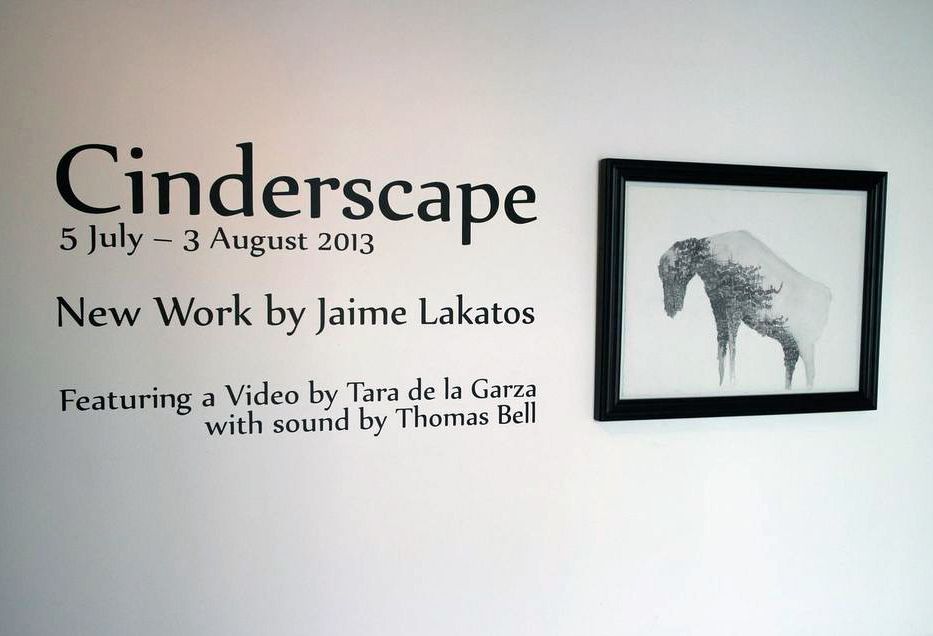 |
| Jaime Lakatos Installation view of "Chronic Remorse" Watercolor and graphite on paper 14 x 18 inches 2013 |
Jaime Lakatos: I grew up in New York, about an hour from the city, on Long Island.
Where on Long Island?
Port Jefferson, right where the ferry goes to Bridgeport.
So, you’re obviously interested in natural history. Where did that interest come from?
Well, you know, going to the Natural History Museum in New York. That was home base. I had an internship there before I started working in museums thirteen years ago, just making all the architectural models for the new Hall of Ocean Life. Also, when I was in school at RISD, I did a 6-month stint with Kiki Smith. My work was a lot more human body based at the time, and its gradually evolved. It was about parasites in the human body, then animals and humans, and now it’s just animals!
Works for me! And when did you land out here?
Six or seven years ago.
Is your current Oakland Museum preparator position something you landed recently?
No, as soon as I moved here, I started doing freelance work with them.
It seems like the two places you’ve worked out here, the Oakland Museum and the California Academy of Sciences, would be the local meccas for a person who grew up with the American Museum of Natural History as her home base.
Yeah, for sure.
So tell me a bit about this body of work, “Cinderscape.”
Well, it’s about nature being destroyed. Being burnt up in fire is the end; nothing is going to come back from that. I wanted to portray these creatures in my own sort of evolution, where little bits of other pieces of nature are actually helping them out. There are two parts to each one, and parts that you wouldn’t think would go together -- in any way --do. It’s about little bits of live nature emerging from this apparent total destruction, and how nature will prevail no matter what we do.
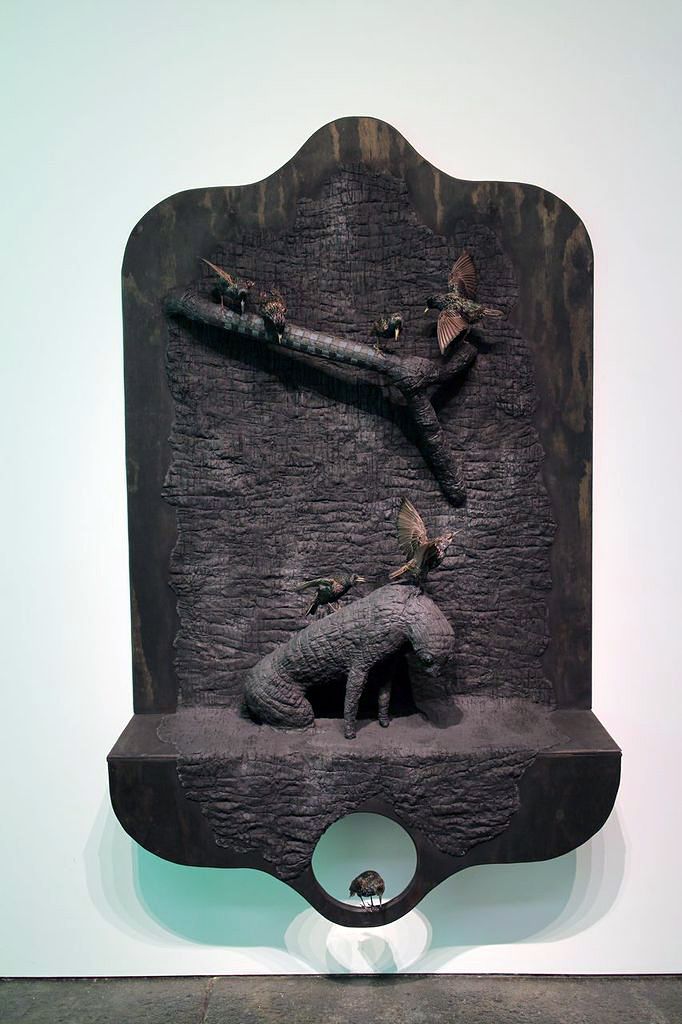 |
| Jaime Lakatos "Dystopia" Wood, hydrocal, resin, fabric, starlings, and graphite 77 x 47 x 14 inches 2013 |
I picked the starling for two reasons. The first one was color.
They are pretty.
The bird’s plumage goes with the palette that I wanted for the piece. The sheen of the burn with the graphite, and then the different greens and purples that you see in their feathers.
The second reason is they’re not protected...and they’re also one of my favorite birds, and I knew that I’d be able to use them. If I wanted a piece with a hawk or something, it just wasn’t possible. Or a crow, or whatever -- you can’t use them. You’re not allowed to taxidermy them unless you have a specific license.
Fascinating. I didn’t realize that.
They’re a lot of birds that, if they’re naturally occurring species in the United States, you can’t kill them for art and you can’t even pick one off the street that you find dead without risking a fine or even jail time.
That’s one of those laws that -- I mean, I appreciate why it’s in place -- but at the same time it confounds sense. I grew up in a rural part of Virginia where we picked up dead things all the time, and my dad had a collecting license from the Smithsonian Institution...
So he could do that!
Yes, but even without the licenses, local folks would pick up birds like owls they found as roadkill and take them to a taxidermist to get mounted for their homes. But that was all illegal, I guess.
All illegal.
So, getting back to the starlings, palette was a big part of the reason for the selection, as well as your love of starlings, and the fact that they’re not protected.
Yeah, and they also work in a group, and the idea for this piece is that this group of starlings -- an unnatural friend to a bobcat -- is trying to help him or her out of this burnt environment.
So you don’t view this bobcat as the desiccated remains of a burnt animal, but actually as something which is struggling to survive?
Yes.
That’s interesting. And did you do all the taxidermy yourself?
No, I have a friend who works with me at the Oakland Museum. I gave her the positions and then she went from there. She does it a hell of a lot faster than I do. Four months and I had just one done, so....
So you have done some taxidermy, then?
Yes, I helped her with an ostrich at the Cal Academy...which was awful. It was like the worst Thanksgiving ever! I was sitting under this big rotting bird and -- oh, God, it smells! -- trying to sculpt legs.
That’s special, though!
Yeah, it was interesting. At certain times, you know, we’d be scraping fat off the hide and it would turn into more of a sewing bee, where we were not really paying attention to the work we were doing, just chatting and everything was fine...but there is fat is flying everywhere.
That’s awesome. That’s kind of like a childhood dream of mine...even though the intense smells weren’t part of the fantasy.
Yeah, well you get used to it, but the first wave is just, like, wow...okay.
Anyway, I had to sculpt the legs because she couldn’t use the actual ones, so if you go see the ostrich at the Cal Academy, those legs are fake -- I made those.
Very cool.
The title of the largest piece in the show, which I therefore think of as the centerpiece...
Yeah, he’s a star, “First Wave.”
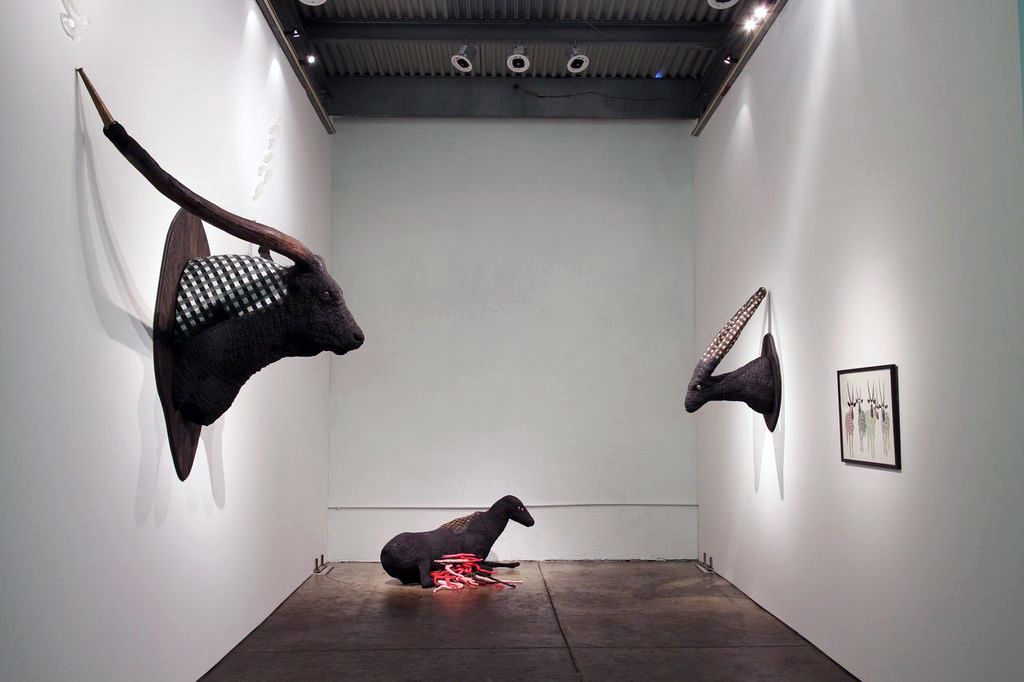 |
| Installation view of "Cinderscape" Jaime Lakatos ("First Wave" is seen on the left wall) |
It’s a steer. A longhorn steer.
So the horns are fire hoses and shooting out of the hoses are different species of fish. It looks like bass and bluegill and something else. Did you choose specific fish or was your choice driven by shape, more of a visual choice?
More visual, definitely. The fish are more like -- well this piece is about procreation, with the bull representing male fertility. It’s a little sexual when you think about it, that these fish are shooting out of his horns.
Umhmm. Especially with the color choices. And I don’t know what you put on the fire hose...a shellac?
That’s a resin.
It looks great. Without the resin, the hose would still look good, but, with it, there is something very organic, even eel-like about it, which heightens the sexual aspect of the piece, I think.
So the steer is the focal point of trying to get this environment back into the shape it used to be by seeding new life. This is the first wave of the new life...
That’s coming out of the old?
Yeah.
That’s great. The chapbook I’m currently producing as part of the Aggregate Space and Featherboard Writing Series writing residency deals with that a bit, life coming out of death. There’s a section about my looking at compost heaps and watching all the maggots and how fascinated I was with that as a child. There’s a lot of darkness in that, but there is also a lot of positive energy. It’s a complicated, messy relationship, but one that I’m fascinated by and that informs all of my art and writing. At any rate, when I first saw your work installed, I was psyched. It seemed fitting that my writing residency here was linked to your solo show. I feel they sync up well. Plus much of my chapbook deals with hunting and because three of the more prominent pieces in the show are shoulder or trophy mounts, well, I have all the hunting trophy associations. Was that something you were thinking about, or is it more secondary for you?
It’s supposed to feel like a natural history collection, but with a different story. I don’t want those three animals to seem like they’re still running in the wild. It’s more like a page from an explorer’s book.
Gotcha. Yeah, “Dystopia” seems very different from those because it isn’t a shoulder mount. Even though it’s mounted on the wall, the birds seem alive -- or I read them as alive -- and, while I had questions about whether the bob cat was alive or not, it is not a trophy mount display. It is a narrative in progress, whereas the other works do have more of a natural history kind of feel, as if they reference an event that took place in the past.
I didn’t want them all to be shoulder mounts because there is a bit of stagnancy with that format. “Dystopia” was the last piece I made for the show and “The Lookout” (a floor sculpture) was the next to last piece.
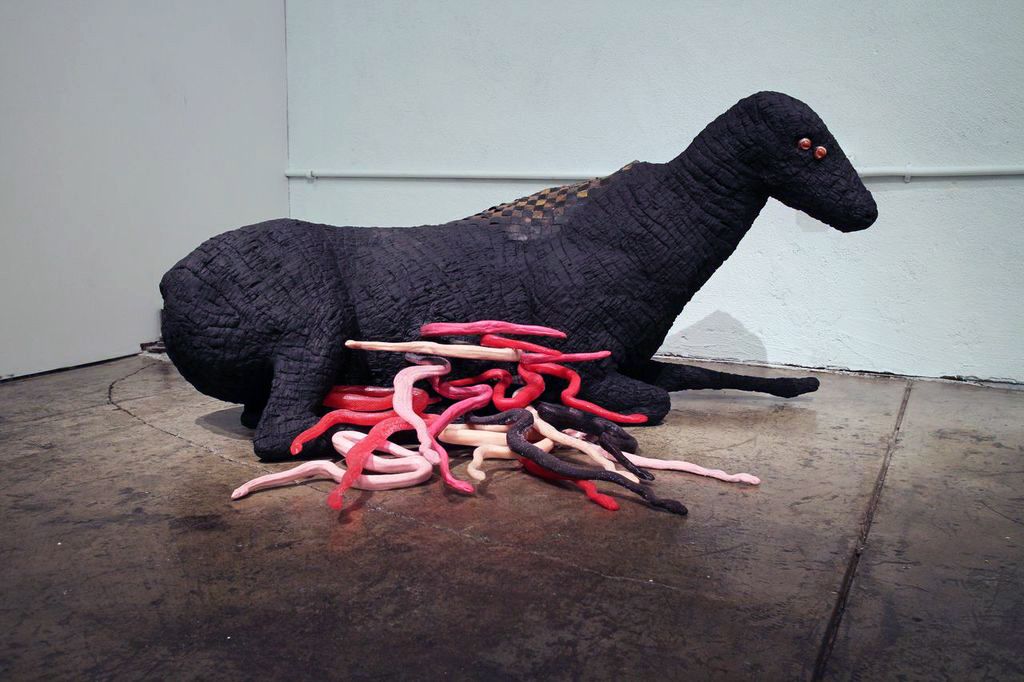 |
| Jaime Lakatos "The Lookout" Hydrocal, fabric, and resin 30 x 58 x 36 inches 2013 |
So the deer has four eyes -- two on a side -- because she is trying to find the next place to go. And the snakes, too, are fanning out to figure out where to head next. What is the next step? What is the way forward? They are the live part emerging from the burned destruction, on their way to find something better, some place that is better.
So, like the bobcat, you view the deer as alive and figuring out how to survive?
Yes.
So even though these animals are charred and fundamentally altered, this is just their new state of being?
Yes, and the woven area of the sculptures represents the skin that was there before, partially exposed. Not everything has been covered by the char, so there is a little glimmer of hope.
It seems as though some of these works, and this one, in particular, taps into a push-pull, looking forward at a possible future and hearkening back to the past, to ancient mythologies. Do you have a lot of interest in mythology?
Sometimes, when I’m doing research on my own for a piece, I usually try to tap into the meaning of snakes, or the meaning of a steer, and I’ll think about that while I’m working. There is a nod to mythology, but it isn’t at the forefront of how I work.
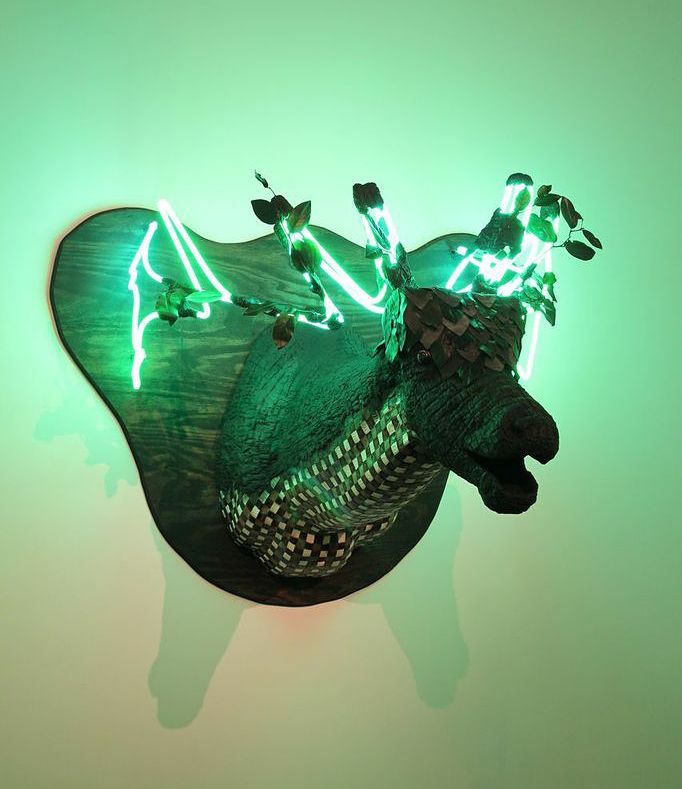 |
| Jaime Lakatos "There Is No Light Without Darkness" Neon, fabric, hydrocal, resin, wood, and graphite 45 x 59 x 51 inches 2013 |
And, then there’s "There Is No Light Without Darkness," the sculpture with the neon element. I’m going to be honest. I love the neon piece best when it -- the neon -- is turned off. I recognize it as neon, of course, but there is something very appealing about the color. I like that stark white color of the neon in contrast to the strong darks of the background and the elk and then how it relates to the patterning on the chest of the elk. But when the neon is turned on -- I mean, I still like it because, you know, it’s neon! -- but the color doesn’t quite work for me because it’s such a potent green...
Yeah, it’s neon. Whatever color you choose, it’s gonna be, like, BING!
Yeah, it does it’s own thing. We just take the ride!
I’m glad it looks good off as well as on, actually. Neon is so delicate and I pushed the limits with the neon when bending them into antlers.
Is there anything else you’d like to say about the work or otherwise add?
Honestly, it may sound a little cliche, but I like hearing what people get out of my work rather than telling them what to think.
One more thing; it looks like you have a bird tattoo on the back of your neck. Oh, they’re crows. Nice. I think a lot of people who know something about birds love corvids. I’m one of them, and I get excited whenever I see ravens or crows around.
Oh, yeah, I have vultures tattooed on me, crows, all sorts of birds...owls.
All good! All birds I approve of! Not that a warbler wouldn't be pretty, but they’re not exactly tattoo material. ‘I’ll take a chickadee, please.’ That’s another level of keepin’ it real.

No comments:
Post a Comment